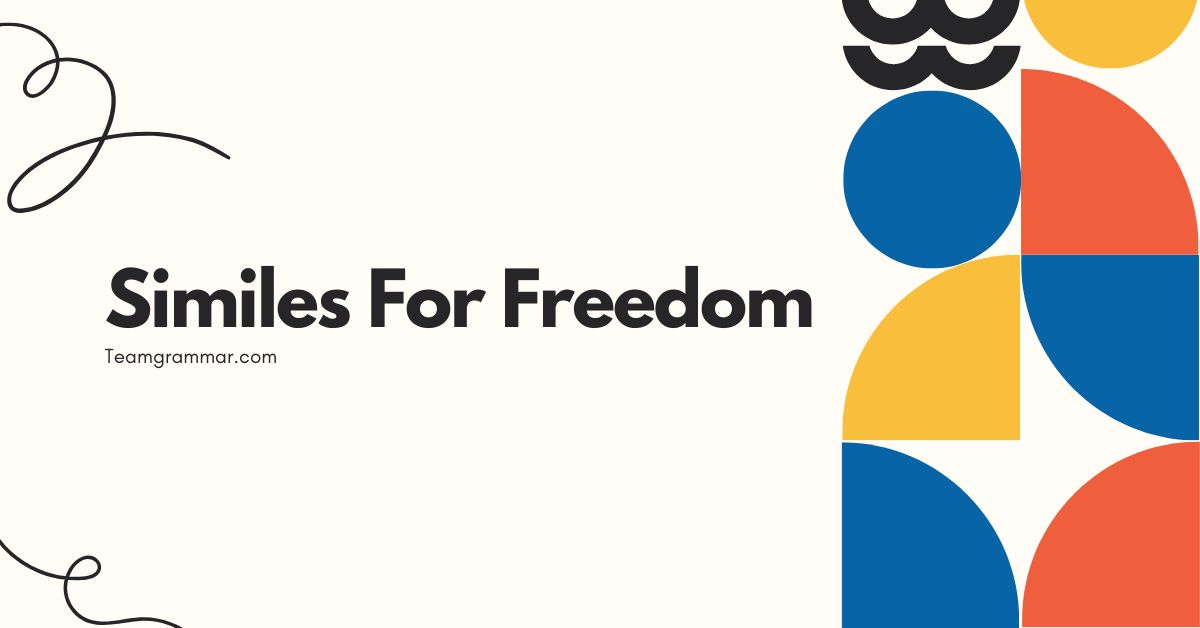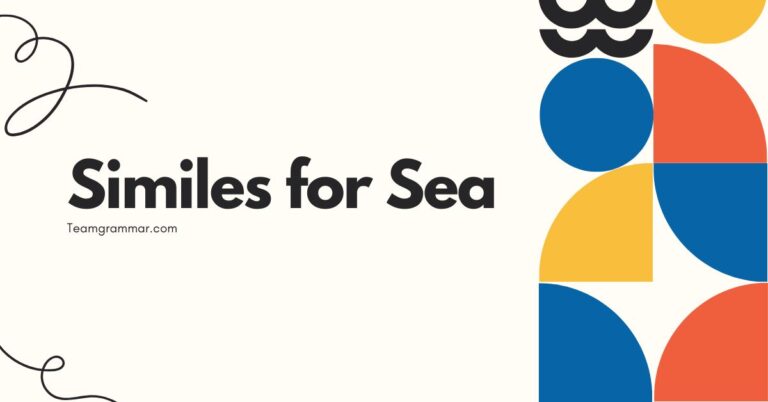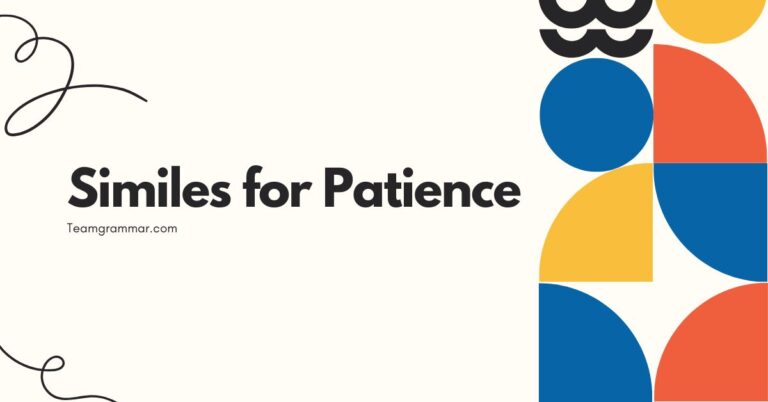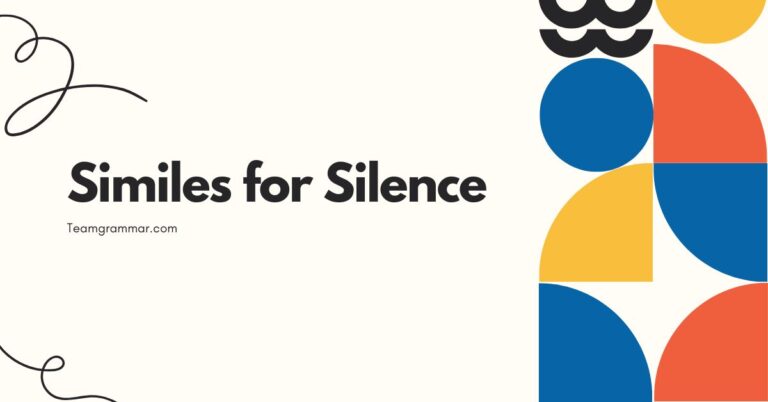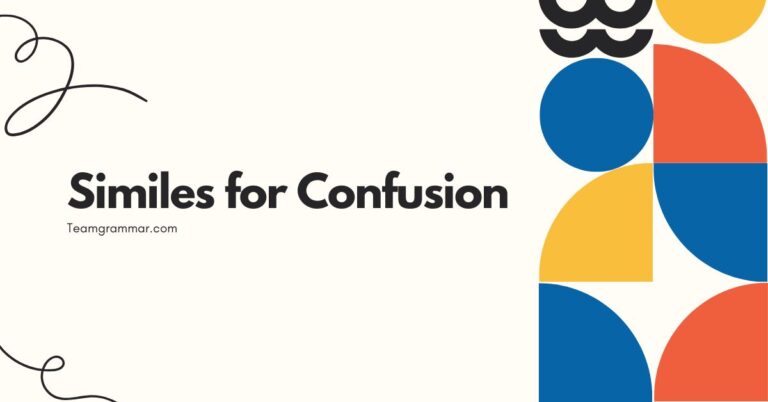33 Similes For Freedom: Grammar, Usage, and Examples
Understanding and using similes effectively is crucial for enhancing your writing and communication skills. Similes, as figures of speech, allow us to draw vivid comparisons, adding depth and color to our language.
Focusing on similes related to “freedom” not only expands your vocabulary but also provides a nuanced way to express complex ideas and emotions. This article is designed for English language learners, writers, and anyone interested in mastering the art of figurative language.
By exploring the structure, types, and usage of freedom-related similes, you’ll gain the tools to express yourself more creatively and precisely.
Table of Contents
- Definition of Similes
- Structural Breakdown of Similes
- Types and Categories of Similes
- Examples of Similes for Freedom
- Usage Rules for Similes
- Common Mistakes with Similes
- Practice Exercises
- Advanced Topics: Nuances in Simile Usage
- Frequently Asked Questions
- Conclusion
Definition of Similes
A simile is a figure of speech that directly compares two different things, explicitly using the words “like” or “as.” The purpose of a simile is to enhance the reader’s understanding and imagination by creating a vivid and relatable image. Similes are essential tools in both literary writing and everyday communication, allowing speakers and writers to express abstract concepts in concrete terms.
Classification:Similes fall under the broader category of figurative language, which includes metaphors, personification, and hyperbole. Unlike metaphors, which imply that one thing *is* another, similes state that one thing is *like* another.
This explicit comparison sets similes apart and makes them a more accessible form of figurative language for learners.
Function:The primary function of a simile is to make a descriptive statement more emphatic or clear. By drawing a parallel between two dissimilar objects or ideas, similes can evoke emotions, create imagery, and make complex concepts easier to grasp.
In the context of “freedom,” similes can illuminate the feeling of liberation, the struggle for independence, or the responsibilities that come with autonomy.
Contexts:Similes are used in various contexts, from poetry and prose to speeches and casual conversations. In literature, they add depth and texture to narratives, helping readers connect with characters and settings.
In persuasive writing, similes can make arguments more compelling by framing them in relatable terms. In everyday speech, they add color and expressiveness to communication.
Structural Breakdown of Similes
The basic structure of a simile involves three key components: the subject, the linking word (“like” or “as”), and the comparative term. Understanding how these components work together is essential for constructing effective and meaningful similes.
Subject:This is the thing being described or compared. It is the entity whose qualities are being highlighted through the simile.
For example, in the simile “His spirit was as free as a bird,” the subject is “His spirit.”
Linking Word:The linking word, typically “like” or “as,” explicitly establishes the comparison between the subject and the comparative term. These words signal that a simile is being used, rather than a metaphor or another type of figurative language.
The choice between “like” and “as” often depends on personal preference or the specific rhythm of the sentence.
Comparative Term:This is the thing to which the subject is being compared. It provides the basis for the comparison, highlighting a shared quality or characteristic.
In the example above, “a bird” is the comparative term, suggesting the subject’s spirit shares the quality of being unconfined and unrestrained.
The structure can be represented as follows:
[Subject] + [Linking Word (“like” or “as”)] + [Comparative Term]
For instance: “Her laughter was like the sound of wind chimes.” Here, “Her laughter” is the subject, “was like” is the linking phrase, and “the sound of wind chimes” is the comparative term. This structure helps create a clear and vivid comparison, enhancing the reader’s understanding of the subject.
Types and Categories of Similes
Similes can be categorized based on the type of comparison they make, the context in which they are used, or the effect they are intended to create. Here are some common types of similes:
Descriptive Similes
These similes focus on describing a quality or characteristic of the subject by comparing it to something else. They aim to create a vivid image or convey a specific feeling.
Emotive Similes
Emotive similes are used to evoke a particular emotion or feeling in the reader. They often compare the subject to something that is strongly associated with that emotion.
Explanatory Similes
Explanatory similes are used to clarify or explain something by comparing it to something more familiar or understandable. They are often used in educational or instructional contexts.
Figurative Similes for Freedom
These similes specifically relate to the concept of freedom, encompassing liberty, independence, and autonomy. They can describe the feeling of freedom, the struggle for freedom, or the responsibilities that come with it.
Examples of Similes for Freedom
Here are some examples of similes related to freedom, categorized to illustrate their diverse applications:
Descriptive Similes for Freedom
Descriptive similes for freedom paint a picture of what freedom looks or feels like by comparing it to tangible objects or experiences. These similes help to convey the essence of freedom through vivid imagery.
| Simile | Explanation |
|---|---|
| His spirit soared like an eagle released from its cage. | Describes the feeling of liberation after being confined. |
| Freedom felt as light as a feather floating in the breeze. | Conveys the sense of ease and weightlessness that comes with freedom. |
| Her voice, once silenced, now rang out as clear as a bell. | Illustrates the newfound ability to express oneself freely. |
| Their hearts beat as one, like a chorus of liberated voices. | Emphasizes the unity and shared joy of collective freedom. |
| The open road stretched before them, as boundless as the sky above. | Depicts the limitless possibilities that freedom offers. |
| His laughter was as free as a child’s on a playground. | Compares the uninhibited joy of freedom to the carefree laughter of a child. |
| She moved through the world as gracefully as a dancer unbound by chains. | Illustrates the elegance and fluidity of movement that freedom allows. |
| Their dreams took flight like birds escaping a storm. | Depicts the aspirations that become possible with freedom. |
| The air tasted as fresh as the first rain after a long drought. | Conveys the revitalizing and refreshing nature of freedom. |
| His mind was as open as a vast, unexplored territory. | Illustrates the boundless potential for thought and discovery that freedom provides. |
| Their hope was as bright as a newly lit torch. | Describes the renewed sense of optimism and purpose freedom brings. |
| The feeling of liberation was as intoxicating as a first love. | Conveys the overwhelming and exhilarating sensation of newfound freedom. |
| His ideas flowed as freely as a river finding its course. | Illustrates the uninhibited expression of thoughts and creativity. |
| Her spirit shone as radiantly as the sun after a long night. | Depicts the vibrant and luminous quality of a liberated soul. |
| Their determination was as unwavering as a mountain standing tall. | Emphasizes the steadfast resolve that accompanies the pursuit of freedom. |
| The newly won rights felt as solid as the ground beneath their feet. | Conveys the sense of security and stability that freedom provides. |
| His courage burned as fiercely as a wildfire consuming all obstacles. | Illustrates the intense and unstoppable force of bravery in the fight for freedom. |
| Her words echoed as powerfully as thunder across the land. | Depicts the impactful and resonant nature of free speech. |
| The change was as dramatic as a butterfly emerging from its chrysalis. | Conveys the transformative and liberating nature of freedom. |
| Their unity was as strong as the bonds of a family. | Emphasizes the unbreakable connection forged in the pursuit of freedom. |
| The end of oppression felt as sweet as honey after bitterness. | Illustrates the delightful relief and satisfaction of liberation. |
| His future was as clear as a well-defined path. | Depicts the clarity and direction that freedom provides. |
| The weight of responsibility felt as heavy as carrying the world. | Conveys the burden that can accompany the exercise of freedom. |
Emotive Similes for Freedom
Emotive similes for freedom focus on the emotional impact of liberty, using comparisons that evoke feelings of joy, relief, or empowerment. These similes resonate with the reader on a personal level, making the concept of freedom more relatable.
| Simile | Explanation |
|---|---|
| The taste of freedom was as sweet as victory itself. | Evokes the feeling of triumph and satisfaction associated with liberty. |
| Her heart swelled with pride, like a balloon about to burst with joy. | Conveys the overwhelming emotion of freedom and self-respect. |
| The relief of being free washed over him like a cool summer rain. | Illustrates the refreshing and soothing sensation of liberation. |
| Their spirits lifted as high as kites dancing in the wind. | Depicts the feeling of elation and upliftment that freedom brings. |
| The weight of oppression lifted from their shoulders like a heavy cloak falling away. | Emphasizes the release and relief that comes with being freed from burden. |
| The fear of the past faded like a bad dream upon waking. | Conveys the sense of renewal and optimism that freedom offers. |
| His hope for the future burned as brightly as a beacon in the night. | Illustrates the guiding and inspiring nature of freedom’s promise. |
| The feeling of empowerment surged through her like a tidal wave. | Depicts the powerful and transformative effect of freedom on one’s sense of self. |
| Their voices joined together in song, as harmonious as a choir of angels. | Emphasizes the unity and shared joy of collective freedom. |
| The joy of liberation felt as boundless as the ocean stretching to the horizon. | Conveys the limitless and expansive nature of the happiness that freedom brings. |
| The peace of freedom settled over them like a gentle blanket. | Describes the comforting and calming effect of liberty. |
| Their determination to remain free was as fierce as a lion protecting its cubs. | Illustrates the protective and unwavering nature of the desire for freedom. |
| The promise of a better future shone as brightly as a star in the dark sky. | Conveys the hope and inspiration that freedom offers. |
| The sense of belonging felt as strong as the roots of an ancient tree. | Emphasizes the connection and stability that freedom can provide. |
| The thrill of independence coursed through them like electricity. | Depicts the energizing and invigorating feeling of being free. |
| Their hearts beat with pride as loudly as drums in a parade. | Illustrates the celebratory and triumphant feeling of liberation. |
| The gratitude for their freedom flowed as freely as tears of joy. | Conveys the overwhelming emotion of appreciation for liberty. |
| The newfound confidence blossomed like a flower in springtime. | Depicts the growth and flourishing of self-assurance that freedom allows. |
| The realization of their potential felt as exhilarating as reaching the summit of a mountain. | Conveys the sense of accomplishment and fulfillment that freedom brings. |
| Their resilience shone as brightly as diamonds under pressure. | Illustrates the strength and endurance that freedom can foster. |
| The weight of responsibility felt as heavy as carrying the expectations of generations. | Conveys the solemn and significant nature of the duties that come with freedom. |
| Their voices rang out with conviction as clear as a trumpet’s call. | Emphasizes the powerful and persuasive nature of free speech. |
| The feeling of possibility was as vast as the universe itself. | Depicts the limitless potential that freedom unlocks. |
Explanatory Similes for Freedom
Explanatory similes for freedom clarify the concept of liberty by comparing it to familiar or understandable ideas. These similes are helpful in explaining the complexities and nuances of freedom to others.
| Simile | Explanation |
|---|---|
| Freedom without responsibility is like a ship without a rudder. | Explains that freedom requires guidance and accountability. |
| Free speech is like a double-edged sword; it can build up or tear down. | Illustrates the potential benefits and dangers of unrestricted expression. |
| The struggle for freedom is like climbing a mountain; it’s arduous but rewarding. | Conveys the effort and perseverance required to achieve liberty. |
| Protecting freedom is like tending a garden; it requires constant care and attention. | Emphasizes the need for vigilance and maintenance in preserving liberty. |
| Freedom of thought is like a bird in flight; it cannot be caged or confined. | Illustrates the uninhibited nature of intellectual liberty. |
| The price of freedom is like an investment; it may cost much now, but yields great returns later. | Conveys the idea that sacrifices are necessary to secure liberty. |
| True freedom is like a balanced scale; it requires equality and justice for all. | Emphasizes the importance of fairness and equity in a free society. |
| Democracy without participation is like a body without a soul. | Illustrates the importance of active involvement in maintaining freedom. |
| Freedom of the press is like a watchdog; it guards against corruption and abuse of power. | Emphasizes the role of media in holding those in authority accountable. |
| The pursuit of freedom is like a marathon; it requires endurance and determination. | Conveys the long-term commitment and resilience needed to achieve liberty. |
| Freedom of religion is like a sanctuary; it provides a safe space for belief. | Illustrates the importance of protecting diverse religious practices. |
| Economic freedom is like a ladder; it allows people to climb out of poverty. | Emphasizes the role of economic opportunity in achieving overall liberty. |
| The right to assembly is like a forum; it allows people to gather and express their views. | Illustrates the importance of collective action in a free society. |
| The fight against oppression is like battling a hydra; when one head is cut off, another grows back. | Conveys the persistent and multifaceted nature of the struggle for freedom. |
| Freedom is like a seed; it must be nurtured to grow and flourish. | Emphasizes the need for ongoing support and development of liberty. |
| The responsibility of freedom is like a compass; it guides us to make ethical decisions. | Illustrates the importance of using freedom wisely and justly. |
| Freedom of education is like a key; it unlocks opportunities and empowers individuals. | Emphasizes the transformative potential of access to knowledge. |
| The spirit of freedom is like an ember; it can be rekindled even in the darkest of times. | Conveys the enduring and resilient nature of the desire for liberty. |
| Freedom is like a tapestry; it is woven from the threads of diverse experiences and perspectives. | Illustrates the richness and complexity of a free society. |
| The pursuit of justice is like navigating a maze; it requires patience and perseverance. | Conveys the challenges and complexities of achieving fairness for all. |
Usage Rules for Similes
Using similes effectively requires an understanding of the rules that govern their construction and application. While similes offer creative freedom, adhering to certain guidelines ensures clarity and impact.
Clarity: The comparison made in a simile should be clear and easily understood by the audience. Avoid obscure or overly complex comparisons that may confuse the reader.
Relevance: The comparative term should be relevant to the subject and highlight a shared quality or characteristic. The comparison should make sense within the context of the sentence or passage.
Originality: While some similes are common and widely used, strive for originality in your comparisons. Fresh and imaginative similes can make your writing more engaging and memorable.
Consistency: Ensure that the simile is consistent with the tone and style of your writing. Avoid using similes that clash with the overall mood or message of your piece.
Avoid Clichés: Be mindful of overused similes, such as “as busy as a bee” or “as strong as an ox.” These clichés have lost their impact and can make your writing seem uninspired. Instead, try to create original comparisons that are specific to your subject.
Use Sparingly: While similes can enhance your writing, overuse can diminish their effectiveness. Use them judiciously to emphasize key points or create vivid imagery, rather than peppering them throughout your text unnecessarily.
Common Mistakes with Similes
Even experienced writers can make mistakes when using similes. Being aware of these common errors can help you avoid them and use similes more effectively.
Mixing Metaphors and Similes:One common mistake is confusing similes with metaphors. Remember that similes use “like” or “as” to make an explicit comparison, while metaphors imply that one thing *is* another.
Mixing these two can create confusing or nonsensical statements.
Incorrect: Her voice was a bell, like ringing clearly. (Mixes metaphor and simile)
Correct: Her voice was like a bell, ringing clearly. (Simile)
Correct: Her voice was a bell, ringing clearly. (Metaphor)
Illogical Comparisons: Another mistake is making comparisons that don’t make sense or are not relevant to the subject. The comparative term should have a clear and logical connection to the subject.
Incorrect: His freedom was like a refrigerator. (Illogical comparison)
Correct: His freedom was like a vast, open field. (Logical comparison)
Overusing Similes: As mentioned earlier, using too many similes can dilute their impact and make your writing seem cluttered. Use similes sparingly and only when they add significant value to your description or explanation.
Incorrect: The day was like a dream, and the sky was like a painting, and the birds were like singers. (Overuse of similes)
Correct: The day felt like a dream, with birds singing in the sky. (More concise and impactful)
Practice Exercises
Test your understanding of similes with these practice exercises. For each question, choose the best simile to complete the sentence or rewrite the sentence to include a simile.
Exercise 1: Identifying Similes
| Question | Answer |
|---|---|
| 1. The feeling of freedom was _______. | a) liberating b) like a bird taking flight |
| 2. His spirit soared _______ after the verdict. | a) happily b) as high as an eagle freed from its cage |
| 3. Her determination was _______. | a) strong b) as solid as a rock |
| 4. Their voices echoed _______ across the land. | a) powerfully b) like thunder rolling in the distance |
| 5. The taste of liberty was _______. | a) satisfying b) as sweet as victory itself |
| 6. His hope for the future burned _______. | a) brightly b) as bright as a beacon in the night |
| 7. The weight of oppression lifted _______ from their shoulders. | a) easily b) like a heavy cloak falling away |
| 8. The relief of being free washed over him _______. | a) soothingly b) like a cool summer rain |
| 9. Their hearts swelled with pride _______. | a) greatly b) like a balloon about to burst with joy |
| 10. The promise of a better future shone _______. | a) inspiringly b) as brightly as a star in the dark sky |
Answers: 1. b) 2. b) 3. b) 4. b) 5. b) 6. b) 7. b) 8. b) 9. b) 10. b)
Exercise 2: Completing Similes
| Question | Answer |
|---|---|
| 1. The newly won rights felt as solid as _______. | a) a handshake b) the ground beneath their feet |
| 2. His courage burned as fiercely as _______. | a) a candle b) a wildfire consuming all obstacles |
| 3. She moved through the world as gracefully as _______. | a) a politician b) a dancer unbound by chains |
| 4. Their dreams took flight like _______. | a) airplanes b) birds escaping a storm |
| 5. The air tasted as fresh as _______. | a) bottled water b) the first rain after a long drought |
| 6. His mind was as open as _______. | a) a book b) a vast, unexplored territory |
| 7. Their hope was as bright as _______. | a) a lightbulb b) a newly lit torch |
| 8. The feeling of liberation was as intoxicating as _______. | a) caffeine b) a first love |
| 9. His ideas flowed as freely as _______. | a) traffic b) a river finding its course |
| 10. Her spirit shone as radiantly as _______. | a) a mirror b) the sun after a long night |
Answers: 1. b) 2. b) 3. b) 4. b) 5. b) 6. b) 7. b) 8. b) 9. b) 10. b)
Exercise 3: Writing Similes
| Question | Answer |
|---|---|
| 1. Rewrite: The end of oppression was sweet. | The end of oppression felt as sweet as honey after bitterness. |
| 2. Rewrite: His future was clear. | His future was as clear as a well-defined path. |
| 3. Rewrite: The weight of responsibility was heavy. | The weight of responsibility felt as heavy as carrying the world. |
| 4. Rewrite: The change was dramatic. | The change was as dramatic as a butterfly emerging from its chrysalis. |
| 5. Rewrite: Their unity was strong. | Their unity was as strong as the bonds of a family. |
| 6. Rewrite: The feeling of possibility was vast. | The feeling of possibility was as vast as the universe itself. |
| 7. Rewrite: Their resilience shone brightly. | Their resilience shone as brightly as diamonds under pressure. |
| 8. Rewrite: Their voices rang out with conviction. | Their voices rang out with conviction as clear as a trumpet’s call. |
| 9. Rewrite: The thrill of independence coursed through them. | The thrill of independence coursed through them like electricity. |
| 10. Rewrite: The sense of belonging felt strong. | The sense of belonging felt as strong as the roots of an ancient tree. |
Advanced Topics: Nuances in Simile Usage
For advanced learners, exploring the nuances of simile usage can elevate their writing to a more sophisticated level. This involves understanding the subtle differences between similar similes, using similes to create complex imagery, and adapting similes to suit different contexts and audiences.
Subtle Differences:Pay attention to the subtle differences between similar similes. For example, “as free as a bird” and “as free as the wind” both describe freedom, but they evoke different images and emotions.
“As free as a bird” suggests a sense of lightness and joy, while “as free as the wind” implies a sense of power and unpredictability. Choosing the right simile can significantly impact the tone and message of your writing.
Complex Imagery:Use similes to create complex and layered imagery. This involves combining multiple similes or using similes that build upon each other to create a more vivid and detailed picture in the reader’s mind.
For example, “His spirit was like a river, flowing freely and powerfully, like a force of nature carving its own path.”
Contextual Adaptation:Adapt your similes to suit the specific context and audience of your writing. Consider the cultural background, knowledge level, and expectations of your readers when choosing or creating similes.
A simile that resonates with one audience may not be effective with another. For example, a simile that relies on a specific cultural reference may not be understood by readers from a different culture.
Subverting Expectations:Experiment with subverting expectations by using similes in unexpected or unconventional ways. This can involve comparing seemingly unrelated things or using similes to challenge traditional ideas or perspectives.
For example, “Freedom felt as heavy as chains, binding him to the responsibility of his choices.”
Frequently Asked Questions
Here are some frequently asked questions about similes:
Q1: What is the difference between a simile and a metaphor?
A1: A simile is a comparison between two things using “like” or “as,” while a metaphor implies that one thing *is* another. Similes are explicit comparisons, while metaphors are implicit.
Q2: Can a simile be used with any two things?
A2: While you can compare almost anything, an effective simile requires a logical or meaningful connection between the two things being compared. The comparison should enhance understanding or create a vivid image.
Q3: Are similes only used in writing?
A3: No, similes are used in both writing and speech. They are a common tool for adding color and expressiveness to communication in various contexts.
Q4: How can I avoid using clichés in my similes?
A4: To avoid clichés, try to think of original and specific comparisons that are relevant to your subject. Brainstorm different qualities or characteristics of the subject and then look for unique ways to compare them to other things.
Q5: Is it possible to overuse similes in writing?
A5: Yes, overuse of similes can dilute their impact and make your writing seem cluttered. Use similes judiciously and only when they add significant value to your description or explanation.
Q6: What if I can’t think of a good simile?
A6:If you’re struggling to come up with a simile, try focusing on the specific qualities or characteristics you want to highlight. Then, brainstorm different things that share those qualities.
You can also try looking for inspiration in literature, poetry, or other forms of creative writing.
Q7: How do I choose between “like” and “as” in a simile?
A7: The choice between “like” and “as” often depends on personal preference or the specific rhythm of the sentence. Both words are generally interchangeable, but “as” is sometimes preferred in more formal writing.
Q8: Can a simile be extended over multiple sentences?
A8: Yes, a simile can be extended over multiple sentences to create a more detailed and elaborate comparison. This is often done in longer passages of descriptive writing.
Q9: How can I use similes to create a specific mood or tone?
A9: The choice of comparative term can significantly impact the mood or tone of your writing. For example, comparing something to a bright and cheerful image can create a positive mood, while comparing it to a dark and ominous image can create a negative mood.
Q10: Are there any cultural considerations when using similes?
A10:Yes, it’s important to be aware of cultural differences when using similes. A simile that resonates with one culture may not be understood or appreciated by another.
Consider the cultural background of your audience when choosing or creating similes.
Conclusion
Mastering similes is an invaluable skill for any English language learner or writer. By understanding their structure, types, and usage rules, you can effectively enhance your writing and communication.
Similes add depth, color, and clarity to your language, allowing you to express complex ideas and emotions in a vivid and relatable way. Focusing on similes related to “freedom” provides a nuanced way to explore this essential concept.
Remember to practice using similes in your own writing and speech, and be mindful of common mistakes. Experiment with different types of similes and strive for originality in your comparisons.
By continuously refining your skills, you can unlock the full potential of similes and become a more effective and engaging communicator. Keep exploring, practicing, and refining your understanding to truly master this powerful tool of language.

